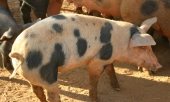There are many types of taint that are blamed on boar taint through confusion:
Boar taint: the real thing - rare but real - most boars don't have it even as adults - comes in multiple chemical forms (two primary), shows at puberty in those few boar line that have it. Duroc is the most known for this but not all of those have it. Control with good genetics, high fiber feed, good management (very clean stalls or better yet pasture rotational grazing). Castration is the conventional solution but only helps with this form of real boar taint but new research is showing that isn't necessary. In Europe they are beginning to ban surgical castration and I suspect that will come to the USA so best to be ahead of the curve on this. Some sows of a specific breed in the Pacific have real boar taint. Note that boars grow faster and are more efficient at turning feed into meat than barrows (castrated males) and barrows are better than gilts so economically it is best to raise boars. Boars are leanest, gilts are fattest on that same spectrum in general - always exceptions but few.
Slaughter Stress: release of stress hormones such as adrenalin at slaughter caused by over excitation making for bad flavor in meat
Porcine Stress Syndrome (PSS): genetic predisposition plus stress at slaughter causes muscle to turn release water and make pork no good, grey, spongy, watery. Occasionally I've heard this confused with taint because of the stress relationship.
Blood Spot: Failure to quickly bleed such that blood pressure spikes breaking small capillaries in the meat, especially the hams. Unsightly but fine to eat. Possible that a high strung boar who gets slaughter stressed would be more likely to have this because the slaughterer might be hesitant to approach the stunned animal or may have inappropriately stunned and missed the blood release timing which is only about 30 seconds to commence to drop the blood pressure as the pH soars due to CO2 concentration build up causing the heart to speed up.
Blood Taint: Failure to bleed out fully leaves blood in meat which changes flavor of meat and makes it more prone to spoilage. Many people don't like the flavor. Others don't mind it. Caused by bad sticking, failure to hang upright to get the last blood, impatience, etc.
Temperature Abuse: Failure to get the animal heat out of the carcass quickly enough or failure to keep the meat cool enough during chilling, handling, storage, thawing such that rotting sets in. Don't eat as this could be a biological hazard - e.g., bacterial infestation and unsafe food.
The link below leads to an index of my various writings and research into the topic of taint for those who want to dig deeper:
http://www.sugarmtnfarm.com/?s=taint
Cheers,
-Walter Jeffries
Sugar Mountain Farm
Pastured Pigs, Sheep & Kids
in the mountains of Vermont
http://SugarMtnFarm.com/
 1
1








 4
4












 2
2








 1
1









































